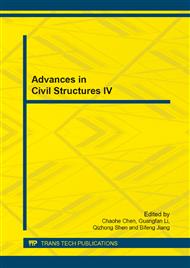p.1449
p.1454
p.1459
p.1464
p.1469
p.1473
p.1477
p.1482
p.1489
The Research on Computation of Researchers Certainty Factor of Bridge's Durability Evaluation Based on the Indeterminate AHP
Abstract:
Because of fuzziness, uncertainty of structure and researchers practical experience, it is more practical to express the relative importance of indexes with interval number. Firstly, according to researchers indeterminate judgment matrix, the upper and lower bound matrixes are formed; secondly, the similarity and the differences of the upper and lower bound matrixes of the relative importance matrix from different experts is studied by using the similarity theory of vector; lastly, certainty factor of researchers according to the upper and lower bound matrixes can be calculated, and the average value is regarded as the researchers certainty factor. The certainty factors of researchers upper and lower bound matrixes are consider together, the researchers experience is fully considered and the error from indeterminate judgment matrix to indeterminate judgment matrix is avoided. The result affords basis to calculate the weight coefficient, the research result comparing with the other method showed that the computation accuracy in this paper was very high.
Info:
Periodical:
Pages:
1469-1472
Citation:
Online since:
July 2014
Authors:
Price:
Сopyright:
© 2014 Trans Tech Publications Ltd. All Rights Reserved
Share:
Citation:


